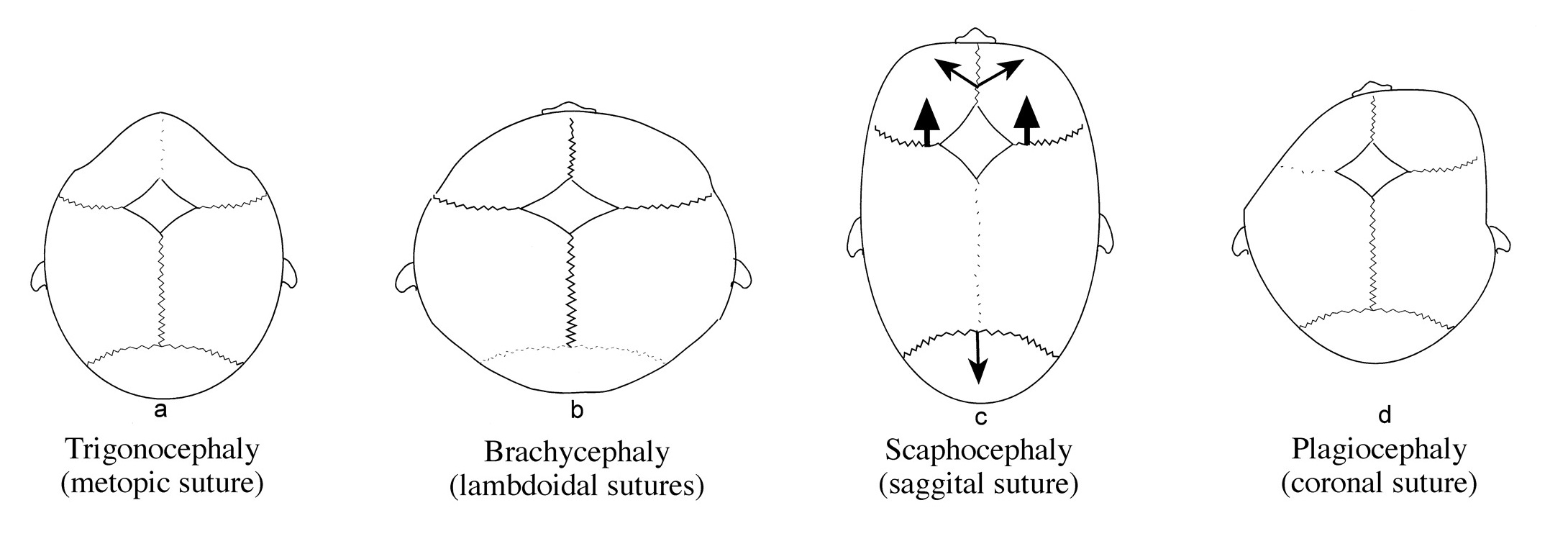What is craniosynostosis?
Cranio·syno·stosis - Craniosynostosis results from sutures in the skull closing to early during a baby’s development. When a baby is born, the skull is made up of several bones that are separated by spaces called sutures. Sutures make new bone as the skull grows. Eventually the sutures close and the individual bones of the skull fuse together into one solid piece of bone. However, in a baby with craniosynostosis the sutures close too soon and prevents the skull from growing properly. During this time the brain keeps growing and in order to make room for it, the sutures that are not closed make more bone then they normally would. This results in uneven growth which effects the baby’s head shape. Only one in twenty-five hundred babies with an odd head shape will have craniosynostosis. In fact, more often the head deformity is referred to as flat head syndrome or plagiocephaly which can be diagnosed by an orthotist or local cranial center.
What types of craniosynostosis are there?
• Sagittal craniosynostosis is the most common form of craniosynostosis. This occurs when the rear bones fuse together, and the front bones don’t which leads to an elongation of the skull. (Figure C)
• Coronal craniosynostosis can affect one or both coronal sutures. One will see a flatness on the side if the head where this condition exists. In addition, the nose will take on a slight tilt towards the side where craniosynostosis takes shape. Noses tilts occur in about fifteen percent of babies with synostosis. The baby will begin to take on a shorter head shape from front to back which is referred to Brachycephaly. (Figure D)
• Metopic craniosynostosis or premature fusion of the sutures in the front of the head occurs in about fifteen percent of babies with craniosynostosis. Some children will have a ridge over front suture which does not always require surgery. The real problem occurs when the front of the head takes on a triangular shape which in most cases will require an operation. (Figure A)
• Lambdoid craniosynostosis is the least common form of craniosynostosis. This occurs when one of the sutures in the back of the head fuse together prematurely. This can result from poor positioning habits when the baby is sleeping or in a stationary environment. (Figure B)

Where does the Cranial Therapy Centers come in?
During the craniosynostosis surgery recovery, doctors will require a cranial helmet to make sure that the bones in the skull fuse together properly. Cranial Therapy Centers will work with your doctor to provide the right helmet therapy to give your baby the perfect head shape. Our hope is that in years down the road no one will ever notice that this child went through a craniosynostosis surgery.
If you are concerned about the shape of your child’s head, do not hesitate to consult your pediatrician who will determine the need for professional assessment and treatment.
Treatment options
Doctors often recommend surgery to return a baby’s skull to a more typical shape. In some children craniosynostosis can affect brain growth and development which is why it's vital to be seen by a specialist sooner than later. Surgery gets more complicated when the skull begins to fuse together. Though surgeons can handle any craniosynostosis condition, it’s ideal to treat before the sutures close completely. This allows doctors to reform the bones to form together a healthy-looking skull. If your child is under three to six months, there may be a minimally invasive endoscopic operation for the treatment of that craniosynostosis.
The Cranial Therapy Centers collaborate with doctors to prescribe and provide the most effective treatment module.

